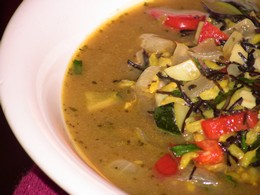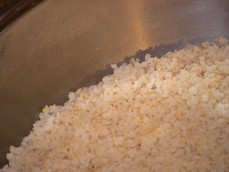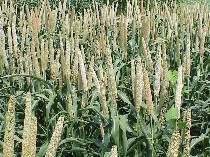December 1st, 2007
 On a couple of occasions we’ve been asked about how to make gluten free baked products lighter (we understand that “door-stop bread loaves” are just not the fashion any more); and how to make your own self-rising flour for use in gluten free cooking.
On a couple of occasions we’ve been asked about how to make gluten free baked products lighter (we understand that “door-stop bread loaves” are just not the fashion any more); and how to make your own self-rising flour for use in gluten free cooking.
As is the case with all kinds of flours, the only difference between the “plain” and the “self-raising” flour, is that the self-raising has had chemical leavening agents (baking powder) added to it that causes it to rise (this process was first invented back in the mid-1800’s B.T.W.).
What You Need To Know About Baking Powder:
Typical quantities of baking powder used in a recipe would be as follows:
100grams of flour,
3 grams of baking powder
and just a pinch of salt (up to 1 gram).
The basic formulation for baking powder itself, varies, but it commonly contains sodium bicarbonate (an alkali) combined with a starch (to keep it dry) and some form of acid salts such as cream of tartar or certain aluminum salts. (Here is a LINK to ingredients used in common baking powders plus more fascinating info)
It’s the body’s excessive exposure to aluminum salts that are of BIG concern. These are usually found in what are called “double-acting” baking powders and should be avoided. Studies have presented compelling evidence of aluminum being directly linked with senility and Alzheimer’s, just to name a few. (Other aluminum-containing formulations are found quite commonly in underarm deodorants as well). …… To read the rest of this entry CLICK HERE »
Posted in gluten free cooking recipes, gluten free cooking video | No Comments »
November 25th, 2007
 This is not an article about gluten free cooking, about celiac, or even how to live a gluten free life. It’s more about facing the challenges that come with the condition.
This is not an article about gluten free cooking, about celiac, or even how to live a gluten free life. It’s more about facing the challenges that come with the condition.
Someone once told me that “The challenges that we face, day to day, are just opportunities to overcome”. The magnitude and circumstance may vary, but the challenge remains the same.
We all have our victories, as we also have our setbacks.
How we handle either is an indication of how
much we have developed inside.
If the severity of your gluten intolerance is extreme and your ability to deal with the emotional and physical issues at hand are pushed to their limits, then it’s the “inner game” that becomes your most potent field of play.
…… To read the rest of this entry CLICK HERE »
Posted in Inspirational Support, Roadmap For Gluten Free Cooking | No Comments »
November 23rd, 2007
This dish is one of our favorites. It is quick, simple, very nourishing and awesomely tasty. The liquid base for this recipe is a good quality chicken broth, that we almost always have on hand either in the fridge or freezer.  (for those unfamiliar with the best way to make broth, we’ll demonstrate the method we use at a later time).
(for those unfamiliar with the best way to make broth, we’ll demonstrate the method we use at a later time).
We also like to use Sea Vegetables as much as possible. Arame (the black slivers you see in the photo) was used for this recipe. It is available in most healthfood stores or Japanese food outlets. It is very mild to the taste, is one of the richest sources of iodine and also high in calcium and iron. It has lots of applications and is very easy to work with.
…… To read the rest of this entry CLICK HERE »
Posted in gluten free cooking recipes | No Comments »
November 12th, 2007
I’ve actually been trying some things I’ve never quite done before (in this way), so it has been my opportunity to have some fun. (It is also my excuse to get to have more time in the kitchen as well…… “Move over sweety, I’ve got some more of my millet project to do !!” 
I find it interesting that I tend to see lots of fancy, gluten free recipes out there,  but very little of the simple stuff. Maybe I’m only one of a few who feel it is important to get to learn to work with basic, wholefood ingredients first.
but very little of the simple stuff. Maybe I’m only one of a few who feel it is important to get to learn to work with basic, wholefood ingredients first.
Maybe it’s just a reflection of the complicated culture that we live in, but this simple approach doesn’t seem to get talked about much. So, I invite you to join me and try these simple recipes too. So much can be done with so little.
I hope by now you would have tried out the basic millet recipe in the previous post. It was a wonderful plain, fluffy millet and both Karen and I thoroughly enjoyed a nice portion of that as part of an evening meal. It was a wonderful change from what we had been having.
…… To read the rest of this entry CLICK HERE »
Posted in gluten free cooking recipes, gluten free grains | 2 Comments »
November 8th, 2007
Now that you have the right kind of Millet as described in the previous post, you can feel confident that if you follow the directions in this blog you’re going to end up with a delicious and wholesome dish that just about anyone would enjoy.
 Most Westerners, unfortunately, still associate millet with bird seed and it might take a little while to adjust to the idea of using it. The use of this gluten free grain, however, goes back thousands of years in Asia, Eastern Europe and parts of the African continent.
Most Westerners, unfortunately, still associate millet with bird seed and it might take a little while to adjust to the idea of using it. The use of this gluten free grain, however, goes back thousands of years in Asia, Eastern Europe and parts of the African continent.
We were first attracted to using it ourselves years ago because we were looking for ways of including more alkalizing foods in our diet, while at the same time getting a bit more variety and excitement into our meals. We were surprised to find millet to be a versatile and “friendly” grain suitable for many types of occasions.
Millet has an Alkalizing Effect on the Body:
As you probably know, the Western diet tends to be more acid forming and an overly acid system means “trouble”, stressing the body’s reserves of alkaline minerals and resulting in many and varied states of dis-ease. The good news is that millet plays its part in helping to restore balance in this regard (along with most land vegetables, sea vegetables, good quality sea salt, and a list of other special foods).
…… To read the rest of this entry CLICK HERE »
Posted in gluten free cooking recipes, gluten free grains | 1 Comment »
 On a couple of occasions we’ve been asked about how to make gluten free baked products lighter (we understand that “door-stop bread loaves” are just not the fashion any more); and how to make your own self-rising flour for use in gluten free cooking.
On a couple of occasions we’ve been asked about how to make gluten free baked products lighter (we understand that “door-stop bread loaves” are just not the fashion any more); and how to make your own self-rising flour for use in gluten free cooking. 


 (for those unfamiliar with the best way to make broth, we’ll demonstrate the method we use at a later time).
(for those unfamiliar with the best way to make broth, we’ll demonstrate the method we use at a later time). 
 but very little of the simple stuff. Maybe I’m only one of a few who feel it is important to get to learn to work with basic, wholefood ingredients first.
but very little of the simple stuff. Maybe I’m only one of a few who feel it is important to get to learn to work with basic, wholefood ingredients first.  Most Westerners, unfortunately, still associate millet with bird seed and it might take a little while to adjust to the idea of using it. The use of this gluten free grain, however, goes back thousands of years in Asia, Eastern Europe and parts of the African continent.
Most Westerners, unfortunately, still associate millet with bird seed and it might take a little while to adjust to the idea of using it. The use of this gluten free grain, however, goes back thousands of years in Asia, Eastern Europe and parts of the African continent. 
